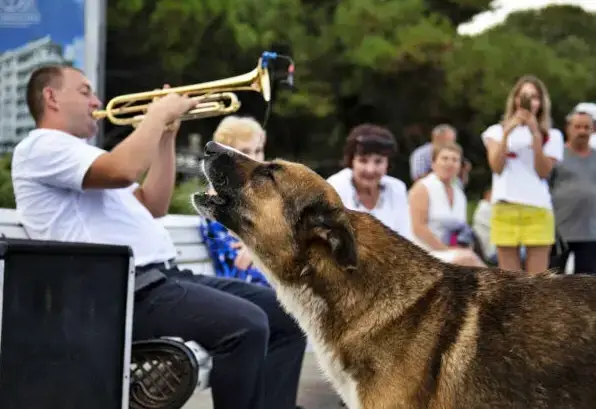Dogs Sing. Every dog owner has likely experienced it at least once. You’re relaxing at home, perhaps listening to music, when suddenly your four-legged companion lifts their head, closes their eyes, and lets out a surprisingly melodic, soulful howl.
It’s a moment that can range from hilarious to deeply moving. They might be “singing” along to a passing siren, a violin solo on the radio, or even your own off-key shower performance.
While it’s easy to dismiss this as a quirky canine antic, scientists and animal behaviorists now understand that there are profound and fascinating reasons behind these impromptu concerts.
From the ancient echoes of their wild ancestors to a sophisticated form of emotional expression, let’s delve into the captivating world of why our dogs sometimes become true vocal virtuosos.
Dogs Sing or Call of the Wild.
An Ancestral Symphony.
To truly understand why a pampered poodle might suddenly sound like a lone wolf, we must travel back in time. The domestic dog, Canis lupus familiaris, is a direct descendant of the gray wolf, and despite thousands of years of domestication, they retain a powerful genetic link to their wild kin.
For wolves, howling is not a random act; it is a vital and complex form of social communication. It is their long-distance telephone, their community bulletin board, and their national anthem all rolled into one.
A wolf pack howls to accomplish several key tasks:
• Territorial Declaration: A coordinated group howl sends a clear and resonant message to neighboring packs: “This land is ours. Stay away.” The sound can travel for miles, establishing boundaries without the need for physical confrontation.
• Pack Cohesion and Location: When members of a pack become separated during a hunt, a chorus of howls helps them locate one another and regroup. It’s a sonic beacon in the vast wilderness.
• Social Bonding: Howling together strengthens the intricate social bonds within the pack. It’s a unifying activity, a declaration of identity and solidarity that reinforces their connection.
When your dog hears certain sounds, particularly sustained, high-pitched tones like those from a flute, a clarinet, or a human singing it can trigger this deeply ingrained ancestral memory.
On a primal level, these sounds are interpreted as a howl from a distant pack member. The instinct to respond, to join the chorus, is overwhelming. Their seemingly random “singing” is, in fact, an answer to a call that has echoed through their lineage for millennia.
What we perceive as a musical performance is their way of saying, “I hear you, and I am here.”
A truly remarkable example of this is the New Guinea Singing Dog. This rare and ancient breed, native to the highlands of New Guinea, is renowned for its unique and highly tonal vocalizations.
Their howls are not monotonous; instead, they produce a complex sequence of notes with clear pitch changes, often compared to the song of a bird or even the yodel of a human singer.
This incredible vocal ability offers a living glimpse into the potential acoustic complexity that may have been present in the ancestors of all modern dogs.
A Musician’s Ear.
The Science of Canine Hearing.
While instinct lays the foundation, a dog’s unique physiology plays a crucial role in their musical inclinations. It’s no secret that dogs possess an extraordinary sense of hearing that far surpasses our own.
A healthy human adult can typically hear frequencies ranging from about 20 Hertz (Hz) to 20,000 Hz (or 20 kilohertz, kHz).
Dogs, on the other hand, can detect frequencies up to an astonishing 45,000–65,000 Hz.
This incredible range means they perceive a world of sound that is completely inaccessible to us. High-frequency sounds produced by instruments like violins, flutes, and even certain electronic tones in music are far more prominent and stimulating for them.
This is why a dog might remain indifferent to a deep bassline but will instantly perk up and perhaps begin to vocalize when a high-pitched soprano voice or a piercing whistle enters the melody.
It’s not about the volume but the specific frequency and timbre of the sound that “hooks” their attention. The sustained, pure tones seem to most closely mimic the structure of a natural howl, making them almost irresistible to join.
Singing from the Heart.
Emotion, Empathy, and Stress.
Beyond instinct and physiology, a dog’s “singing” is a powerful channel for emotional expression. Just as we might sing in the shower when we’re happy or listen to somber music when we’re sad, dogs use vocalization to process and communicate their feelings.
• Loneliness and Separation Anxiety: A long, mournful howl can be a clear sign of a dog feeling lonely or stressed when left alone. It’s a call for their “pack” (you and your family) to return. In this context, the howl is an attempt to alleviate their own anxiety and re-establish contact.
• Joy and Excitement: Conversely, a dog might join in with a song when they are happy and excited. When an owner returns home and starts singing a cheerful tune, the dog’s accompanying howls are a way of participating in the shared joy and amplifying the positive energy of the moment.
• Empathy and Connection: Dogs are masters at reading human emotions. They are incredibly attuned to our moods and often seek to support us. When you are singing, whether joyfully or melancholically, your dog may join in as a form of social participation. It’s their way of saying, “I’m with you. We are doing this together.”
This desire to form a duet is a beautiful testament to the deep bond shared between humans and their canine companions. They aren’t just making noise; they are actively seeking to share an experience with the person they love most.
The Breed Spotlight.
Born Performers.
While any dog of any breed can surprise their owner with a sudden musical outburst, certain breeds are genetically predisposed to being more “talkative” and musical. These breeds often have a closer working history or genetic lineage to their wolf ancestors.
Among the most renowned canine crooners are Siberian Huskies, Alaskan Malamutes, and Samoyeds. These northern sled dog breeds were bred to work in teams and use a complex array of vocalizations to communicate over long distances in noisy, snowy environments.
For them, howling is second nature. Similarly, hound breeds like Beagles, Basset Hounds, and Coonhounds were selectively bred to use their voices to signal to hunters when they had located prey.
Their famous “baying” is a type of melodic, resonant howl that is music to a hunter’s ears.
Paws on the Playlis.
Canine Music Preferences.
So, if you wanted to encourage a sing-along with your furry friend, what should you put on the stereo? Believe it or not, scientists have studied this very question.
A notable study conducted by the Scottish SPCA and the University of Glasgow exposed shelter dogs to various genres of music and monitored their physiological and behavioral responses.
The results were fascinating. While classical music had an initial calming effect, the dogs quickly grew accustomed to it. The genres that elicited the most positive and sustained reactions were reggae and soft rock.
The gentle rhythms and simple, melodic patterns of these genres appeared to have the most universally calming and engaging effect, reducing stress and encouraging relaxed behaviors. Pop music and classical also ranked favorably.
Many owners have anecdotally reported their dogs’ love for specific songs, noting a particular fondness for artists with smooth, melodic vocals.
Compositions often mentioned include:
• Bob Marley & The Wailers – “Could You Be Loved”
• Eagles – “Tequila Sunrise”
• Steely Dan – “Hey Nineteen”
• Even festive classics like Wham!’s “Last Christmas” and “Jingle Bells.”
It seems that dogs, much like humans, appreciate music that is either rhythmically engaging or, conversely, slow and soothing.
The chaotic and unpredictable nature of genres like heavy metal, on the other hand, was found to often increase agitation and anxiety.
In the end, a dog’s howl is far more than just noise. It is a multi-layered form of communication, a bridge to their ancient past, a response to the world of sound they uniquely perceive, and a heartfelt expression of their emotions.
So, the next time your dog joins you in a spontaneous duet, don’t just laugh. Marvel at the incredible symphony of instinct, biology, and emotion you are privileged to witness, and perhaps, sing a little louder with them.
It’s one of the most beautiful and honest conversations you can ever have.
Have a Great Day!






